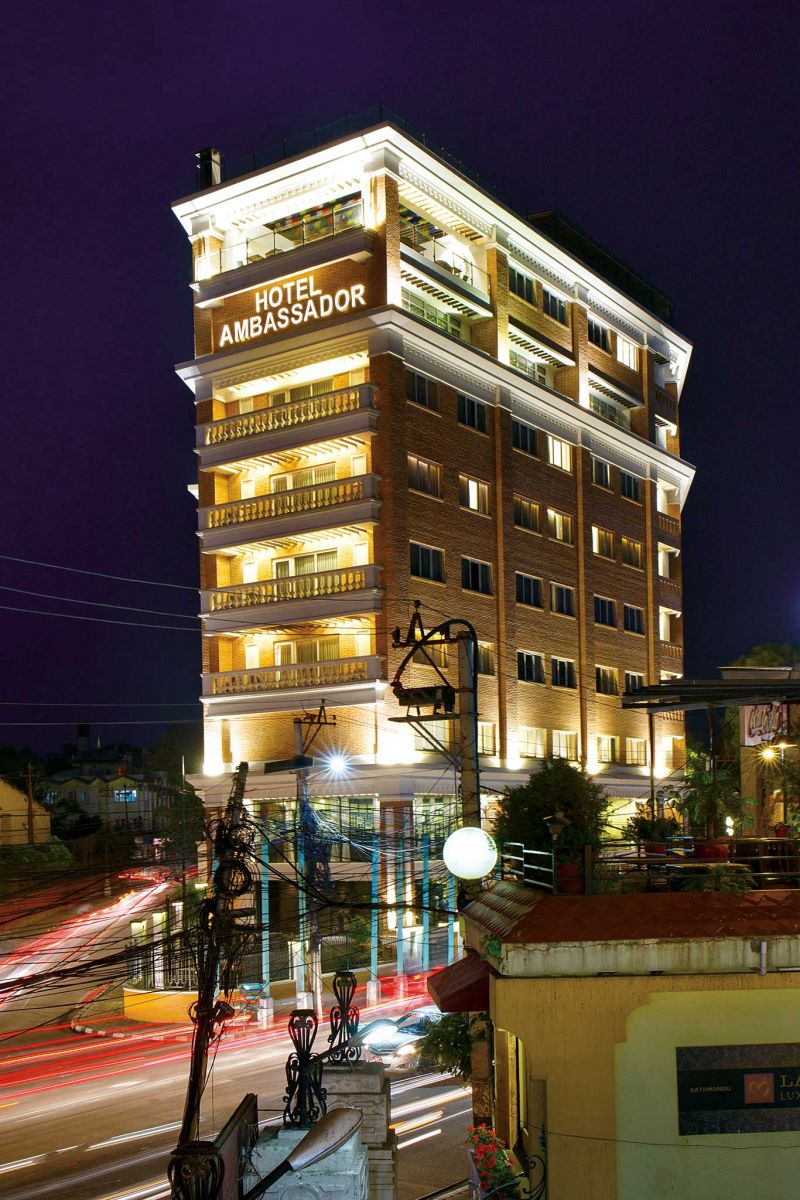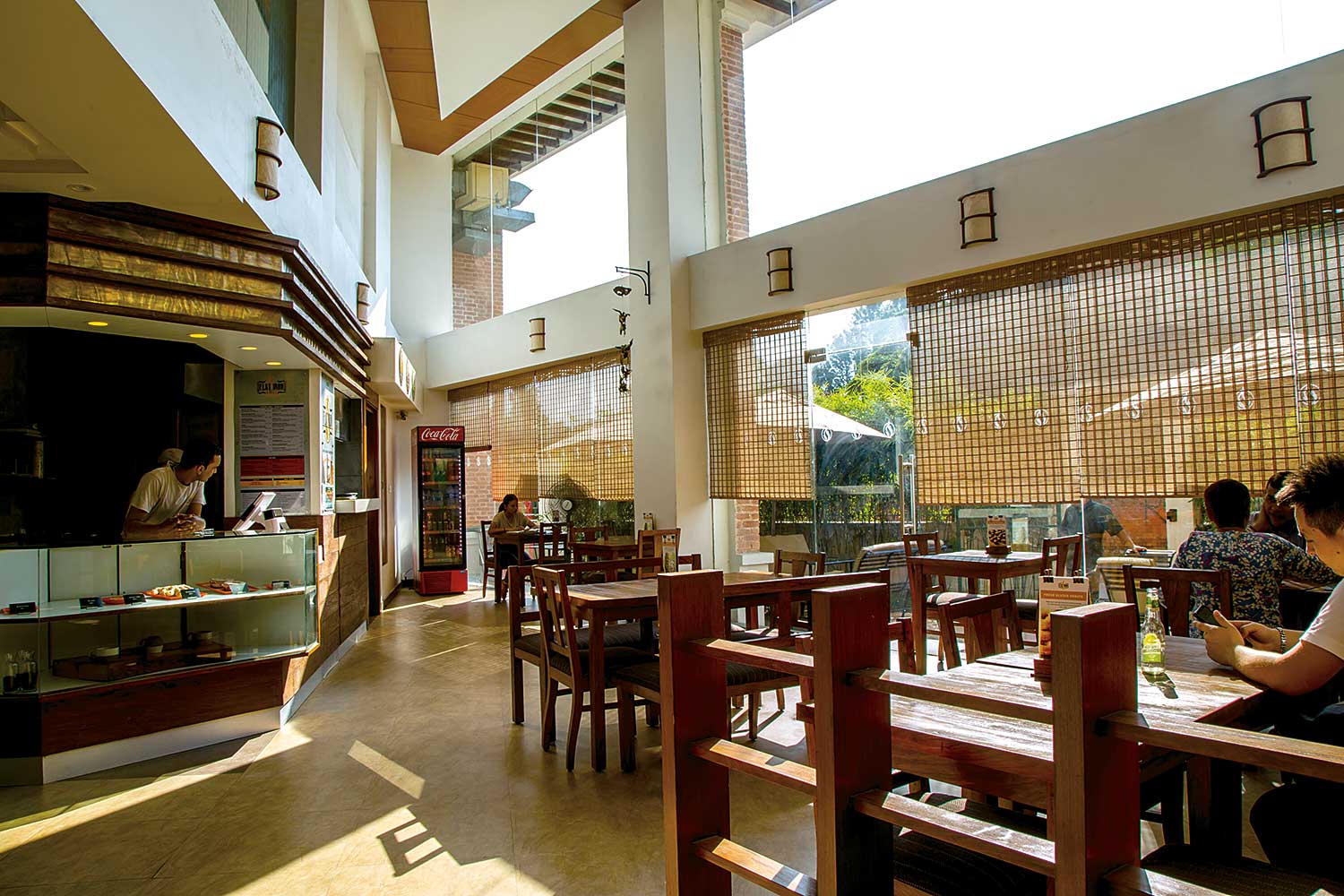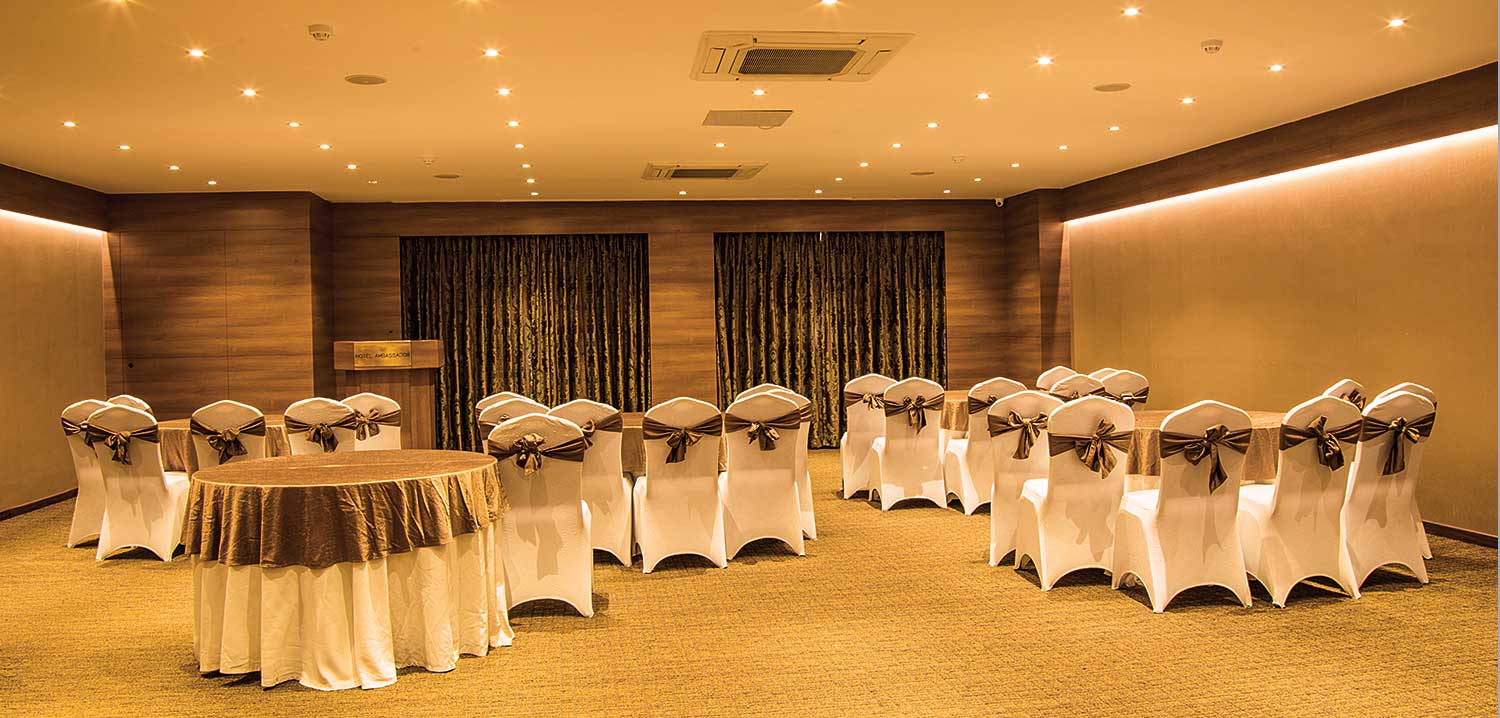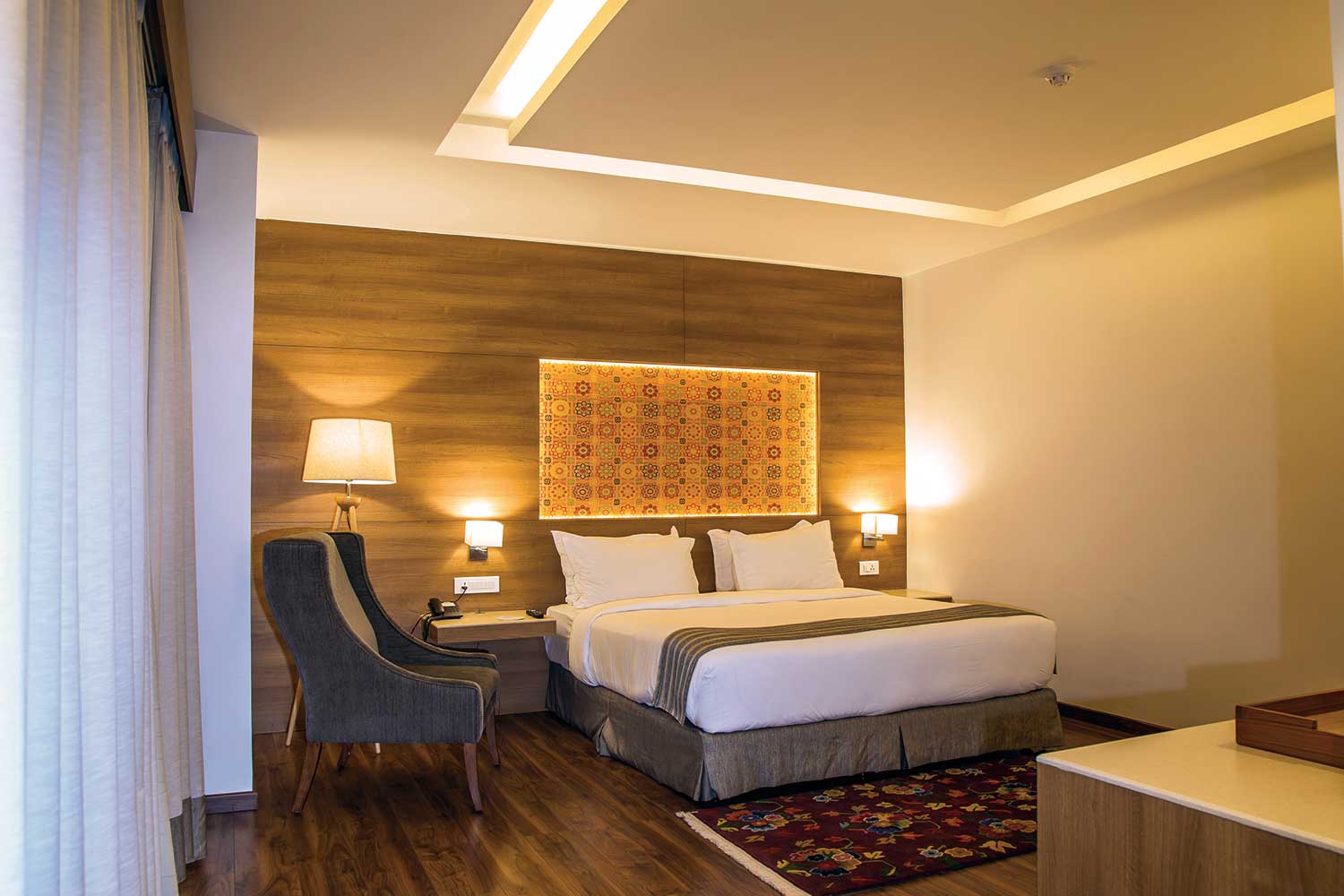 Anyone who lives on the north side of town, as I do, has seen the transformation that the Hotel Ambassador has undergone over the years. From a cozy, welcoming, and much-loved institution to the tall and beautiful building that stands on the corner today, as if guarding the entrance to Lazimpat. For those of us who make the daily commute this way, it always draws the eye.
Anyone who lives on the north side of town, as I do, has seen the transformation that the Hotel Ambassador has undergone over the years. From a cozy, welcoming, and much-loved institution to the tall and beautiful building that stands on the corner today, as if guarding the entrance to Lazimpat. For those of us who make the daily commute this way, it always draws the eye.
Once you step inside, there is something very open and welcoming about it. The first time I walked inside—because my favorite Japanese restaurant, Kotetsu, had relocated here—I was impressed by how much it didn’t feel like a typical hotel, in a good way, and this was back before the building had even reopened as a hotel. The vibe starts from when you walk in; there’s a pleasant reception entrance, of course, but you can also come in via the shops at the front, or through the downstairs restaurant, the American-style Flat Iron Grill. There’s no feeling of being where you don’t belong or of having to explain your presence, it all feels very relaxed and casual, and distinctly contemporary, like you are encouraged to wander.
“Let me give you a little history of the hotel...” I am sitting with owner Yogendra Sakya, longtime hotelier and tourism entrepreneur. We traveled back in time as he spoke of his father, Basanta Bahadur Shakya, a jeweler whose small business in Asan could no longer prove enough to sustain the extended family that he became responsible for on the death of his own father. Mr.Shakya had a small piece of land not far from the British and Indian embassies, and in 1963 he had the idea to build a bungalow that he could rent out for extra income. The idea was nearly unheard of at the time, but it was a great success; the building was rented by the second-in-charge at the British embassy at the time, and soon others were building houses in the Lazimpat area for the same purpose. In fact, I was fascinated to learn that one of the rumored origins of the name ‘Lazimpat’ is on account of the area being known as ‘lodging path’, which then morphed its pronunciation until it became Lazimpat. “I think this story is important, when this family went into hotels, how did they start? A lot of people don’t know this story, and it will take you back to the legend of how we went into the hotel business,” Yogendra tells me.
And this then is the original origin tale of a building that would become a hotel, because in 1978, Basanta Bahadur Shakya decided that instead of continuing to rent the building out, he would turn it into a hotel. Despite being a jeweler by trade, he loved construction, restoration, and old buildings, and keeping the original bungalow, he added several wings, and so was born the Hotel Ambassador.
“My father never thought of destroying old buildings, he always restored, unlike me who tore down everything,” says Yogendra with a laugh. “He was still alive, by the way, when I tore this down. It was difficult; he was quite sentimental about it.” As can be well imagined—it represented the idea that came to his aid and kept his family afloat during one of their toughest moments. And of course, the decision to pull down the hotel and build anew was not something anyone would have willingly chosen. But, in 2011-12, the government began their road expansion program (which I learned during this conversation was actually a plan by the late King Birendra, which in a strange twist of irony, was implemented by a political party and prime minister who fought against the monarchy). Engineers were consulted, who determined that removing part of the structure would weaken it dangerously.
“So, I said, ‘pull it down.’ I had put a big sign [outside the building] saying, ‘change is opportunity’, and I remember getting a text from Hisila Yami, the wife of Baburam Bhattarai who did the road expansion, and she said, ‘Oh, you are so positive, so nice to see such a positive message’, and I sent her a text back in Nepali – there’s a song: ‘mutumathidhungarakhi, hasnuparya cha’, meaning that I have a rock on my chest, but I’m still smiling. At that time, it was smiling with a rock on my chest, but today this smile is genuine, because I think that I did the right thing. So, change, now I really feel, is an opportunity.”
It was, in fact, the third time the family lost land to the ever-widening road, the first two times being in 1961 and 1986 during the two visits of Queen Elizabeth. This is probably the one instance (or two, rather), when this location was the source of the problem: the fancy cars and horse-drawn carriages to be used to drive the monarch between the airport, the British Embassy, and SitalNiwas (now the Presidential residence) where she would be staying were just too large for the small roads then. Considering all of us, I find Yogendra’s optimism even more remarkable; rather than continuing to feel hard-done by, he’s incorporated these stories into the historical lore and weave of his current, modern structure. Everything that was has formed what is now.
 I also learn that the unusual open-plan design of the hotel came about because of the way these external factors produced an unusual land size, rather than some grand design. “We have very limited land, number one, and it’s very odd shaped land, so it was quite a challenge,” Yogendra explains. “Because if had put walls everywhere, it would all have been very dingy. Also, when I was designing the layout and the exterior, I wanted to make it such that the two [bottom] floors get the open feel that you’re talking about, because I wanted to rent them out and make it like a commercial area where people can just walk in, walk out, and don’t feel any restriction of ‘can I go in there’ but where everybody should feel comfortable to walk in walk out, like a public place.” It makes me smile to think that part of the reason for the welcoming openness of the property was quite simply the need to accommodate this oddly-shaped piece of land. Change really is opportunity. While he planned the exterior, it’s his son, Rahul Sakya, who is responsible for the interior design, “The interior design is by my son, so if there is a youthfulness, a freshness to the hotel, then that credit goes to Rahul; we didn’t have an interior designer, he did it all.”
I also learn that the unusual open-plan design of the hotel came about because of the way these external factors produced an unusual land size, rather than some grand design. “We have very limited land, number one, and it’s very odd shaped land, so it was quite a challenge,” Yogendra explains. “Because if had put walls everywhere, it would all have been very dingy. Also, when I was designing the layout and the exterior, I wanted to make it such that the two [bottom] floors get the open feel that you’re talking about, because I wanted to rent them out and make it like a commercial area where people can just walk in, walk out, and don’t feel any restriction of ‘can I go in there’ but where everybody should feel comfortable to walk in walk out, like a public place.” It makes me smile to think that part of the reason for the welcoming openness of the property was quite simply the need to accommodate this oddly-shaped piece of land. Change really is opportunity. While he planned the exterior, it’s his son, Rahul Sakya, who is responsible for the interior design, “The interior design is by my son, so if there is a youthfulness, a freshness to the hotel, then that credit goes to Rahul; we didn’t have an interior designer, he did it all.”
Yogendra Sakya has also chosen to do things a bit differently with the hotel’s restaurants: he believes very firmly that restaurants run by families are better than those run by hotels, because they will be focused and the food will be fresh and not mass produced. So, while the hotel does have its own restaurant, The Diplomat, the other three are independent restaurants run by those most familiar with the kind of food they serve, Kotetsu, Flat Iron Grill, and Momo Queen. Again, it’s a bit of a revolutionary concept for a hotel here, but I think it’s a brilliant idea, focused more on providing the customer with quality and variety rather than worrying about competition. A rooftop bar is in the works, and it will be interesting to see what that becomes, considering that the view alone will make it worth a visit.
 It’s clear on the day of my visit, and from the roof’s vantage point I can see across the city in all directions: the tall buildings, the greenery, the landmarks, and beyond them, the outline of the hills. If Nepal is going to achieve two million tourists by 2020, which is the stated government goal—if that is even possible—it’s going to take some thinking outside the box, and Hotel Ambassador seems perfectly placed; it’s already doing just that.
It’s clear on the day of my visit, and from the roof’s vantage point I can see across the city in all directions: the tall buildings, the greenery, the landmarks, and beyond them, the outline of the hills. If Nepal is going to achieve two million tourists by 2020, which is the stated government goal—if that is even possible—it’s going to take some thinking outside the box, and Hotel Ambassador seems perfectly placed; it’s already doing just that.









